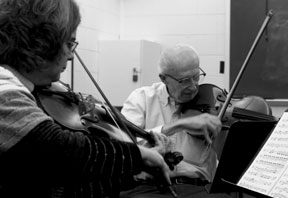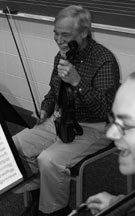Music every Friday afternoonby Dick Strawn |
| Printer-friendly version | Email this article |
|
The press of studies, sometimes frantic, yielded for a time to music's paradoxical claim—move out of yourself the better to move further into yourself, and enjoy the doing.
In the beginning were sessions of piano ensembles at Margaret Forbes's house, with the emphatic violinist Mrs. "Ziggy" Zieman, who thought I was a wimpy player (and I was-then). The Community Orchestra that had flourished in the 1930's and '40's was gasping but still emitting music for fun, and I would take violinist Hazel Gronert down to the Chapel basement to meet up with violist Ted Bedrick and hornist Walt Fertig and others for the likes of Haydn's "London" Symphony. Before violinist Moses Brand was graduated in 1957, he and I played the transcribed Bach double concerto with pianist Louise Bruce in Tuttle Hall (Harold McDonald's gallery); he thought, rightly, that I was still a wimpy player. My word for it was "Apollonian"; I'd picked that up one Christmas night at a gathering at Owen Duston's on East Wabash, where a guest doing palm readings opined that people with blunt fingers tended to be Dionysian and those with slender, tapering fingers like mine were Apollonian. Fancy that. Later, though, still with slender, tapering fingers, I would cut loose. After the Mielkes got back to town from the Northwest in 1957, Mary Lou and stray string players and Paul McKinney or Lew Salter would get together of an evening at 1000 South Grant at our fire-sale piano. That was better than nothing. But the steady, fulfilling kind of playing began in the fall of 1966 when David Greene arrived. He was a whiz of a sight-reader at the keyboard, and what came to be known as the Flat Baroque Ensemble formed: flutist Mary Lou Mielke, cellist Andrée Stern, David, and I, playing Telemann, Bach, Pepusch, Tartini-and, in 1968, enjoying our 30 seconds of national fame on CBS. Bert Stern had organized the publicity and doings for Eugene McCarthy's campaign appearance at the Court House downtown, including our high-toned ensemble, caught-briefly-on the evening news. (Butch Shearer made a slight stink about use of the College harpsichord in a partisan event; we volunteered to stop playing for free at College events. A draw.)
Through the '60's and '70's we were blessed with student players who took time for both a chamber orchestra and Sunday afternoon sessions of string quartets: violinists David Petering '64 and Dexter Snyder '64; violist Carlos Armstead '71; violinists Peter Komsiski '76 and Stephan Wilson '76; cellist Carl Michaelis '79. What some of them claimed to find there was a surcease. The press of their studies, sometimes frantic, yielded for a time to music's paradoxical claim-move out of yourself the better to move further into yourself, and enjoy the doing. It was energetic, too; string players move a lot. Wind instruments joined us sometimes: clarinetists like Rand Nilsson '67 and Alan Willadsen '82; flutists Peter Calkins and Jim Swift, oboists Jeff Stack and his wife-to-be, Kathy Mielke; and bassoonist Paul Mielke Jr. Chemist David Phillips has been a welcome and reliable violinist from the days in 1975 when Herman and Patience Berg came up from Greencastle to teach young and old, civic and on-campus, in the music department's string program. (What is it with those chemists and violin playing? Crusty old Doc Howell, too, had a violin!) In 1978, the librarian-violinist John Swan romped in. Violinist Ginny Maharry arrived sedately in 1979. Philosopher Cheryl Hughes would add her strong viola in 1992, classicist Randy Scholtz his cello in 1997. Students like cellist David Roberts '97 and violinist Tim Houchin '98 joined in earnestly and helped keep us going. We seldom knew for sure what violists and cellists were in the offing, and I had found it useful to take up first the one, then the other. (I learned later that my friends in the Chapel-basement Music Department had had enough of my cello exercising but had been too kind to complain to me—not that I would have suspended.) Now here we are with the pleasures of trios, quartets, quintets-even a sextet. The music department attracts enough good string players that most of them give their playing time to the chamber orchestra and private work.
Our Friday afternoon rump sessions bring out oldsters and the mature and some young blood: David Phillips and Cheryl Hughes; violinist Eileen Bowen, the indispensable doyenne of the Fine Arts building; cellist Matt Bentley, a new Spanish teacher for whom we'll be plumping for tenure; student cellists Daniel Carraway '07 and Braden Pemberton '07. Playing chamber music, even for us amateurs, is a kind of teamwork, probably more like rowing than like football, and close to weaving. We are playing within time and responding to one another within that on-going moment. Small wonder that we no sooner end than we are ready to start again. We play and listen in a haven safe enough for us to be intrepid; we'll tackle (football?) anything-perhaps not Bartok quite yet. For an hour or so we fiddle away, cushioning the hard edges of the College, as Cheryl Hughes says of her own experience. No words, no numbers—except, of course, for the mysterious part of music, its mathematical armature—and a lot of physical and psychic breathing. It's a kind of transport. It is, again paradoxically, a grounded transcendence. And a whale of a lot of fun. Man alive! Contact Professor of French Emeritus Dick Strawn at: strawnd@tds.net Photos: first photo, right: Dick Strawn and Cheryl Hughes; second photo, left: David Phillips; third photo right: Friday afternoon music (from left) Cheryl Hughes, Dick Strawn, Matt Bentley, Eileen Bowen, and David Phillips.
|



